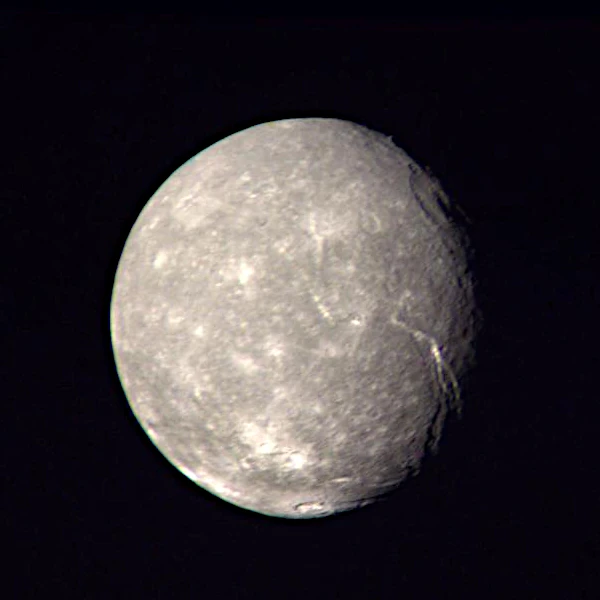
Titania was discovered in 1787 by William Herschel (1738–1822). It is the largest moon of Uranus (and the eighth largest in the Solar System). It orbits at an average distance of \(a \approx 436,300\ \mathrm{km}\) from Uranus’ center, with an orbital period of about 8.7 days. Its mean radius is \(R \approx 788\ \mathrm{km}\) and average density \(\rho \approx 1.66\ \mathrm{g.cm^{-3}}\), indicating a composition of ice (water, volatiles) and rocky material.
Images and measurements obtained during the Voyager 2 flyby in 1986 show a heavily cratered surface, punctuated by fault systems and troughs (grabens) suggesting passive tectonic activity. Linear features, sometimes associated with fracture networks, indicate thermal and mechanical history where contraction and expansion of the icy crust played a role. Albedo variations and brighter regions near some fractures suggest a mixture of materials, including relatively pure water ice deposits and chemically darkened materials.
Mass and density parameters indicate likely partial differentiation: a rocky core surrounded by an ice mantle. Thermal models suggest that during formation, radioactive decay and accretion energy could have warmed the interior sufficiently to produce a partially fluid mantle or even a transient internal ocean. Today, Titania is mostly cooled; however, the fracture configuration and indirect geophysical observations do not rule out the presence of a partially liquid buried water/ammonia reservoir, or a solidified fossil ocean with structural remnants.
Surface temperature averages very low, around \(\sim 60\!-\!80\ \mathrm{K}\) depending on insolation and local albedo. The global geometric albedo is about \(\sim 0.36\!-\!0.40\). Infrared spectroscopy reveals dominant water ice signatures, as well as organic compounds or dark materials modifying surface reflectivity (altered carbon, tholins, or irradiated materials).
| Moon | Radius (km) | Density (g/cm³) | Mean Distance (10³ km) | Atmosphere | Average Temperature (K) | Albedo | Feature |
|---|---|---|---|---|---|---|---|
| Titania | ≈788 | ≈1.66 | ≈436 | None | ≈70 | ≈0.36–0.40 | Largest Uranian moon, tectonic faults and grabens |
| Oberon | ≈761 | ≈1.63 | ≈584 | None | ≈70 | ≈0.22–0.26 | Heavily cratered surface, dark regions |
| Ariel | ≈578 | ≈1.66 | ≈191 | None | ≈70 | ≈0.30–0.40 | Young terrains, canyons and tectonic signs |
| Umbriel | ≈585 | ≈1.45 | ≈265 | None | ≈70 | ≈0.16–0.20 | Very dark regions, heavily cratered |
| Miranda | ≈235 | ≈1.20–1.20 | ≈129 | None | ≈70 | ≈0.30–0.40 | Extreme topography: coronae, cliffs, terraces |
Sources: NASA – Uranus Moons, NASA / JPL – Voyager 2, ESA – Data and summaries.
Titania's geology combines ancient cratering and signs of tectono-cryogeological reworking. Linear grabens and troughs result from crustal stretching, possibly linked to differential heating and cooling of the icy mantle. Thermal models indicate that ammonia as an antifreeze lowers the water melting point and allows for a past ductile mantle behavior; this helps explain observed morphology without requiring currently intense activity.
From an exobiological perspective, Titania is poorly favorable for complex prebiotic processes on the surface (lack of atmosphere, low temperatures). However, if a transient subsurface ocean existed, it could have produced localized chemical conditions of interest (water-rock interactions, chemical gradients). These episodes remain theoretical but are potential targets for future orbiters and landers searching for geochemical signatures of past transformations.